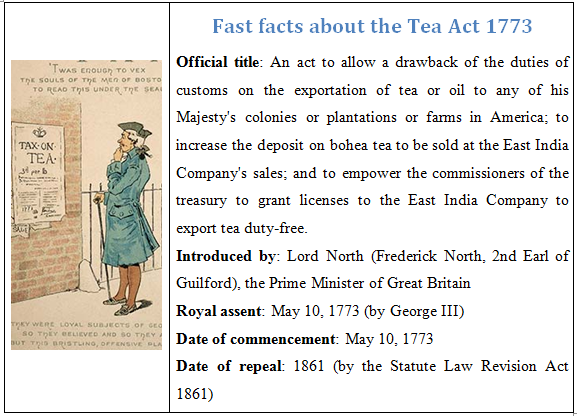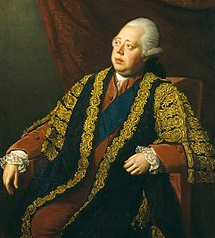Tea Act 1773: History, Date, Facts, & Significance

Tea Act of 1773
When the British Parliament passed the Tea Act in May 1773, the goal was to help the financially struggling British East India Company. The company, also known as the East India Trading Company (EITC), was incurring huge inventory cost due to its London warehouses overflowing with tea. By placing duties on the tea brought into the American colonies, Parliament hoped to turn around the fortunes of the company.
Another equally important objective of the Tea Act of 1773 was to provide the British government with some bit of revenue to defray the mountain of debt it had accumulated a decade earlier in the Seven Years’ War. The legislators in London had gravely underestimated the immense opposition that would stem from the American colonies to the Tea Act, which in turn led to more coercive measures taken by the British government; about two years later, the British Parliament had its hand full as it had to grapple with a full-blown war (i.e. the American Revolutionary War) with the colonies.
What other objectives did the British government have in mind when it passed the Tea Act of 1773? What was the reaction from the American colonies to the Tea Act? And how did the act add more fuel to the fire that was already brewing across the 13 American colonies? Below, we explore in full details the purpose, effects and outcome of the Tea Act of 1773.
Great Britain’s financial woes following the Seven Years’ War
Between 1756 and 1763, Great Britain waged a fierce and financially costly war against its European neighbor France. In what is commonly termed as the Seven Years’ War, the British crown gained vast territories during the war; however, all that came at huge financial cost. With the Britain’s coffers running dry, the Crown and Parliament had to take some drastic measures to offset the cost it was still incurring by keeping a standing army in the 13 American colonies.
In the fall of 1765, the first of a series of controversial measures was taken by the British Parliament. That measure came in the form of the Stamp Act. Known as the first direct tax of its kind in the colonies, the Stamp Act, which imposed taxes on items like legal documents and printed materials, the Stamp Act was met with never-before-seen outrage across the American colonies. Colonists from all walks of life demanded the repeal of the Stamp Act as the described it as unconstitutional and unfair. Protests and agitations ensued, with opponents of the Act demanding representation in the British Parliament if direct taxes were to be imposed on them. So the slogan “taxation without representation” was coined.
Ultimately, Parliament budged and repealed the Stamp Act in 1766. However, the British Parliament still firmly believed that the American colonies had what it called “virtual representation”, meaning Parliament had the right to tax the colonies since it represented the interest of the American colonies. Therefore in 1767, the Townshend Act was passed. Once again, a heavily indebted Britain need money to balance its book so to speak. Named after the then Chancellor of the Exchequer Charles Townshend (i.e. a position more like Secretary of the Treasury in the U.S.), the Townshend Act sought to generate revenue for the British government through duties placed on goods coming into the American colonies, including glass, paint, tea, and paper. Similar to the Stamp Act, the Townshend Act worsened the already frosty relationship between the American colonies and the British government. The colonists reacted by heavily boycotting those taxed goods. By 1770, the Townshend Act had been repealed, bar the duty on imported tea.
British East India Company and its warehouse of unsold tea
With many of the measures in the Townshend Act removed, some colonists went back to purchasing tea. However, the majority of the tea that they bought was actually ‘smuggled’ tea from Holland. The tea that came from England was more expensive than the one merchants brought from Holland. The Dutch tea meant that not only was the British government losing out big from the lack of revenues, it’s prized jewel – the East India Company – was feeling the bite severely. The company had warehouses full to the brim all across London, as it could not sell the tea in the colonies. To make matters worse, the company was not the one selling the tea directly to American colonies. All of those factors made their tea more expensive than the smuggled Dutch tea. The British Parliament devised a measure to rescue the company. That measure came in the form of the Tea Act of 1773. The British Crown (i.e. George III) gave assent to the act on May 10, 1773.
Purpose of the Tea Act of 1773
In addition to the Tea Act of 1773 designed to save the British East India Company from collapsing, the British Parliament hoped to use the act to reinforce its right to tax the American colonies.
The Tea Act gave the East India Company the right to directly sell their tea to the American colonies. What this meant was that the company was in effect cutting out the middleman (i.e. the merchants). Those savings could then be passed on to the final consumer, making the tea cheaper than the smuggled Dutch tea. And even though the duties on the tea had to paid, the price of the East India tea remained cheaper than competition’s.
The third reason for passing the Tea Act was to rein in on smuggled tea. Prior to the Tea Act, about 86% of the tea consumed in the American colonies was smuggled. It means that the British government was losing quite a lot of revenue. The Tea Act was therefore seen by Parliament as a win-win for both the American colonies and the British government. However, that wasn’t the case with merchants who engaged in the business of smuggling Dutch Tea. Those powerful and moderately wealthy merchant mobilized the colonists to protest against the Tea Act. Again the slogan “No Taxation without Representation” was brought up. And so the turbulent years of protests, boycotting and disorder began in the American colonies.
American colonists disguised as Native Americans destroy British Tea
The same group of people – i.e. merchants, smugglers, and artisans – who opposed the Stamp Act 1765 mobilized themselves again to resist what they described as Britain’s continued use of oppression and tyranny in the colonies. Resistance soon turned violent, as the British East India consignees were harassed. Further, the colonies opposed the delivery and distribution of tea. In some colonies, especially in Boston, Massachusetts, the ships carrying the tea were prevented from landing.
Colonists were absolutely furious by the decision of Britain to impose another measure without consulting them. Those affected merchants warned the colonists to fight tooth and nail against the Tea Act, as it was a deceptive tactic by the British government to make the colonies accept its right to impose taxes on the colonies.
In a never-before-seen resistance in the colonies, opponents of the act banded with groups like Samuel Adams’ Sons of Liberty. They tarred and feathered the East India Company’s agents, forcing them into resigning from their jobs.
On December 16, 1773, a group of colonists, possibly affiliated to the Sons of Liberty, dressed as Native Americans went aboard East India Company ships carrying tea and dumped all the tea in to Boston Harbor. The incident was a defining moment in the history of a nation that was yet to be born.
Read More: Biography and Accomplishments of Samuel Adams
Parliament’s reaction to the Boston Tea Party

Boston Tea Party – December, 1773
In addition to the heavy losses that were suffered by the East India Company, the Boston Tea Party was a big blow to the British government. Never in a million years did politicians in London expect the American colonies to react in such a manner. The shock in London quickly turned into complete and utter fury. Parliament went ahead and tightened its grip on the colonies by passing the Coercive Acts of 1774. Known in the colonies as the Intolerable Acts, the Coercive Acts was intended to rein in on protests in the colonies, especially those in Boston. The British government ordered (under the Boston Port Act) the closure of the Boston Port, pending when Bostonians had fully paid for the cost of the damage tea. British military general Thomas Gage was deployed to Boston to server as the governor of Massachusetts. Gage was given clear instructions to bring Bostonians in line and prevent a future occurrence of events such as the Boston Tea Party.
The Intolerable Acts of 1774 achieved the exact opposite of what London aimed for. It gave credence to the debate that Britain’s goal was to eliminate every form of local government and bit of autonomy that the colonists had in running their internal affairs. American colonists began to term the British officials and governors as agents of tyrants living in London. As time progressed more and more moderate Americans began to support radicals’ proposal to get rid of British rule.
In about two years following the Tea Act of 1773, colonial militiamen had taken arms against the British government. On April 19, 1775, the world woke up to news the Battles of Lexington and Concord, as the “first shot that was heard across the globe”. The American Revolution War would rage until 1783, when the Paris Treaty was struck.
Read More: 5 Major Events that led to the American Revolutionary War
More facts about the Tea act of 1773
- In the 3rd year of the American Revolutionary War, the British Parliament passed an act called the Taxation of Colonies Act 1778 to remove many of the measures in the Tea Act. However, the conciliatory move by the British government was anything but a case of “too little, too late”. American Patriots quickly rebuffed the act, as well other proposals from the Carlisle Peace Commission. The Patriots had at the time had only one objective in mind: the complete independence of the nation, which would be underpinned by freedom, liberty and the pursuit of happiness.
- The Tea Act of 1773 remained in the books until it was repealed through the Statute Law Revision Act 1861.
- Many of the consignees commissioned to distribute East India Company’s tea were British loyalists who were favored by the local governors. The fact that a bias process was used in the selection made the colonists even angrier. For example, Massachusetts governor and known British loyalist Thomas Hutchinson had a business that received most the commissions.
- The Tea Act of 1773 in effect made the East Indian Company a monopoly in the tea market. The measures taken by the British government allowed the Company to undercut the prices of the Dutch tea to such an extent that importers of those tea went out of business.
- In Philadelphia and New York, intense resistance to the East India Company’s tea forced some ships to return to Britain with full crates of tea. In some places like Chaleston, the tea was prevented from leaving the port, resulting in them rotting.
Lord North – the British Prime Minister who introduced the Tea Act of 1773

Lord North (Frederick North, 2nd Earl of Guilford) (1732-1792)
Frederick North, 2nd Earl of Guilford, commonly known as Lord North, was the one who introduced the Tea Act. Lord North served as Prime Minister of Great Britain from 1770 to 1782. North was also the Chancellor of the Exchequer. His term as the head of the British government came to an end after it had become apparently clear that the United States was heading for a victory against Great Britain in the American Revolutionary War (1775-1783). On March 27, 1782, he was succeeded by Charles Watson-Wentworth, 2nd Marquess of Rockingham.
























